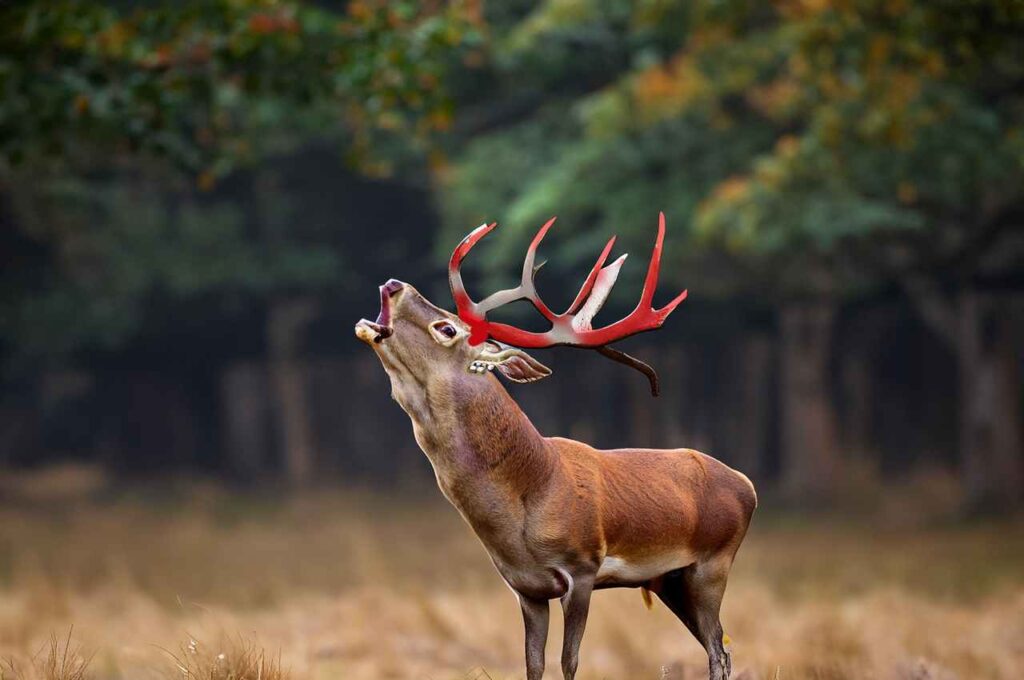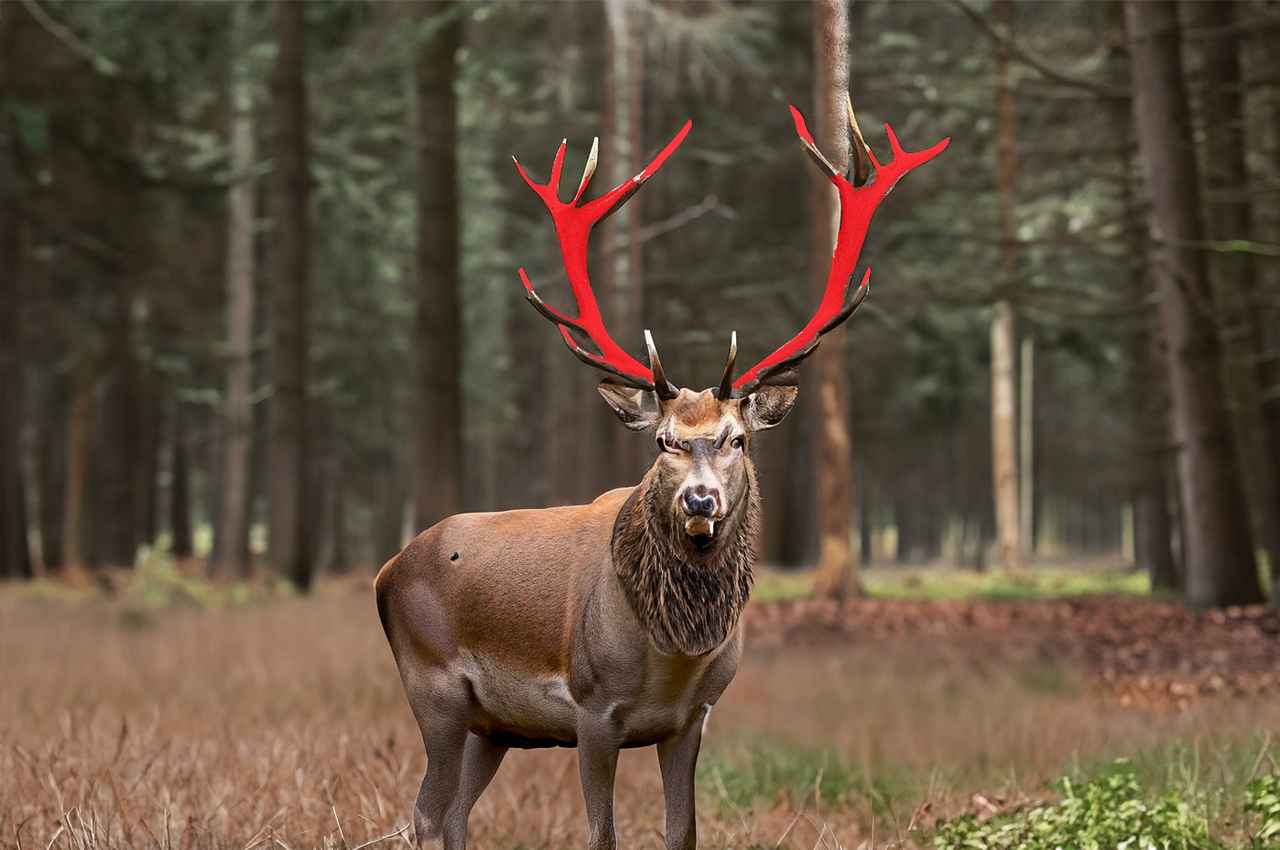Many wonder, is deer shedding velvet painful? While it might be mildly uncomfortable, it’s a crucial phase in their growth. One of nature’s most amazing creations are deer antlers. The spectacular antlers that male deer acquire each year are wrapped in a soft, velvet-like coating as they grow. The velvet covering starts to flake off as fall draws near, showing the antlers underneath, which have stiffened. Although this yearly shedding of velvet is essential for the deer’s mating rituals, it might seem horrifying to the ignorant eye. Bloody strips of tissue hanging from their antlers give the deer an almost frightful appearance. Even though it may seem uncomfortable, the deer’s natural process of losing its velvet is absolutely harmless.
What is Deer Velvet?
The soft, velvet-like coating that envelops the antlers as they develop is referred to as deer antler velvet. Blood arteries and nerves abound in this layer, which provide oxygen and nutrients to sustain fast development. The velvet also serves as a barrier, protecting the developing antlers from harm.
Antler velvet contains several important compounds, including:
- Collagen – Provides structure and flexibility
- Glycosaminoglycans – Promote tissue health and healing
- Growth factors – Stimulate cellular growth and regeneration
- Amino acids – Building blocks of proteins
- Minerals like calcium, magnesium, and zinc – Support bone growth
The antlers are the fastest growing mammalian tissue, expanding up to two inches each day because to their nutrient-rich covering. Additionally, the antlers’ distinctively fuzzy look is due to the velvet.
Is Deer Shedding Velvet Painful?
Many people think deer’s losing their velvet is painful because of the animals’ bloodied, ragged look. However, studies show that the operation is risk-free and painless. This is why:
- By the time the velvet tissue begins to shed, it has already begun to die. Since there is no blood flow, there are no active nerves to detect pain.
- The rubbing does not damage the deer since the antler bone has no nerves.
- Every year, deer naturally shed their skin, doing so without any long-term injury. They seem to have no discomfort after that.
- Deer exhibit normal shedding habits, such as rubbing against trees, indicating they are not bothered by the process.
Therefore, even while velvet shedding may seem gruesome to humans, it is all a normal part of the deer’s cycle. As the velvet sheds, the deer most likely only experiences little itching or discomfort.
What is a deer shedding its velvet?
Every year, deer lose their velvet to prepare for the mating season. Antler development is encouraged by higher testosterone levels in the summer. Fall marks the beginning of mating rituals because of the shorter days and corresponding drop in testosterone levels. Bucks require strong antlers for these rituals in order to assert dominance and engage in combat with rivals. To reveal the solid bone underlying, the nutrient-rich velvet covering must be removed.
The veins around the velvet’s outer surface tighten when testosterone levels drop. The velvet is deprived of blood and nutrients as a result, and the tissue shrivels and perishes. The deteriorating velvet tissue separates from the antler bone and dries up, hanging in strips or finally falling off. Deer often brush their antlers against trees to hasten the loss of their velvet.
What Does Velvet Shedding Look Like?
The velvet’s blood supply automatically contracts when testosterone levels drop, resulting in the velvet’s demise. Deer will start rubbing their antlers against trees in August or September to help remove the loose velvet strips. Initially, patches of velvet begin to fall from the antler tips. It hangs down next to the deer’s head in tattered pieces over time.

The hard, mineralized antler bone may be seen below the velvet after it has been scraped back and rubbed. Velvet tissue that has been stained with blood may hang over the deer’s face. As parts of the velvet’s veins are pulled out, the strips may slightly bleed.
The antlers’ whole velvet coat will fall off in a day or two. The antlers, which are ready to defend the deer against other males, are all that is left. Deer may consume the velvet after it has shed as additional food before it totally comes off.
When Does Deer Velvet Shedding Occur?
| Species | Shedding Period |
|---|---|
| Whitetail Deer | Mid-August to Early September |
| Mule Deer | Mid-September to Mid-October |
| Caribou/Reindeer | August to Late September |
| Elk | August to Early September |
The timing of velvet shedding varies somewhat across deer species living in diverse climes. But shedding usually happens in the latter weeks of summer. Here are a few such timelines:
- Whitetail deer – Shed their velvet from the middle of August until the beginning of September. Late August through early September are prime periods.
- Mule Deer – Mule deer shed their antlers between mid-September and mid-October.
- Caribou/Reindeer – Caribou and reindeer August to the end of September is when they lose their velvet.
- Elk – Elk lose their velvet from late August until the beginning of September.
Deer may lose their velvet early in the case of hot, dry summers. Additionally, young deer often lose their velvet before older males do. Due to more possibilities for rubbing, bucks living in thickly wooded regions may lose their skin in only one day. Deer in open regions might take up to a week to finish.
Behaviors Associated with Velvet Shedding
| Behavior | Purpose |
|---|---|
| Rubbing Antlers on Trees | Scrape off dying velvet tissue |
| Eating the Velvet | Recycle protein content |
| Increased Aggression | Protect themselves while vulnerable |
| Irritability/Restlessness | Deal with itchy sensation |
Due of how crucial the process of shedding velvet is, deer display certain behaviors to aid in the process:
- Rubbing antlers on trees: The most recognizable behavior is this one. To remove the deteriorating velvet tissue, deer brush their antlers on trees. Additionally, when they rub, fragrance from glands on their head marks their area.
- Eating the velvet: Deer may consume some of the shed velvet in order to reintroduce some of the protein to their bodies.
- Aggression: The deer is protected by increased hostility against perceived dangers when its antlers are at risk during shedding. They could display protective behavior against people or other deer.
- Irritability: Some deer seem more agitated and restless during shedding as they cope with the uncomfortable feeling of the velvet falling off. They could regularly shake or toss their heads.
Why Shed Velvet if It Regrows Annually?
Deer spend a lot of work developing a fresh set of antlers wrapped in nutrient-rich velvet each year, so this seems like a reasonable issue. However, while being expensive, growing and losing antlers each year has two major advantages:
- Maximizes mating success: Bucks win rut battles best when they shed velvet and have strong antlers. This lets them mate with most women.
- Indicator of health: The development of superior antlers is a sign of the buck’s health and fitness. Each year, only the healthiest and strongest males can regenerate enormous antler sets. When selecting a mate, does may judge a buck’s genes based on the size and quality of his antlers.
Frequently Asked Questions
Is it painful for deer to shed velvet?
No, when a deer sheds their velvet, they are not in agony. When velvet tissue sheds, it is already dead and cut off from blood flow, thus it has no active pain receptors. Because the antler bone does not have any nerves, rubbing does not hurt.
Do deer bleed when they shed their velvet?
Due of the broken veins and capillaries that occur when velvet sheds, a little quantity of blood could be present. The bleeding, however, is hardly noticeable and ends soon after the velvet is completely removed.
When do deer start shedding velvet?
Late summer, generally from mid-August to early September, is when deer lose their velvet. Geographical location and species influence the precise time.
What time of year do deer shed their velvet?
Every year, between the middle of August and the beginning of September, when their testosterone levels drop, whitetail deer normally lose their velvet.
How often do deer shed their velvet?
Every summer and early fall, deer lose their velvet. Changes in photoperiod and seasonal testosterone levels regulate their antler cycle.
Do Bucks disappear when shedding velvet?
Bucks often live alone and in seclusion when losing their velvet. The fragility that occurs during velvet shedding is what causes this brief absence.
Do Bucks disappear when shedding velvet?
The deer is not harmed by the process of losing the delicate velvet coat. Once the velvet is gone, all that’s left is the hardened antler bone, which doesn’t hurt to touch since it has no nerves.
Will deer use scrapes before they lose their velvet?
Yes, before they completely harden and lose their velvet for the rut season, bucks utilize scrapes to communicate with does and establish their territory.
Will deer use scrapes before they lose their velvet?
It might take a few hours to a few days for the velvet to shed. The majority of deer lose their velvet in 2 days or less.
Do whitetail deer eat their velvet?
In order to replenish their bodies with the protein included in the nutrient-rich tissue, deer do indeed sometimes ingest some of the lost velvet.
Why do deer bleed when shedding velvet?
As the velvet sheds, a little quantity of blood may be present because the velvet’s veins and capillaries are ripped or ruptured. However, once the velvet is removed, bleeding is hardly noticeable and ends soon.
Do deer feel pain when rubbing new antler growth?
No. Rubbing the antler bone does not injure the deer since it lacks pain receptors. The velvet layer that is removed from the skin is already dead and cut off from the blood supply.
What if a deer doesn't shed its velvet?
Deer very seldom keep their velvet beyond the typical shedding cycle. However, if velvet is still present, it can be a sign of an injury, hormonal imbalance, or issue with the mineralization of the antlers.
Can female deer have velvet too?
Yes, but only under extremely special circumstances. Typically, only male deer develop antlers and molt velvet annually. But certain testosterone-rich female deer may grow antlers and velvet.
Conclusion
When asking, is deer shedding velvet painful, it’s essential to understand that it’s a temporary sensation for them. Although it seems ugly to humans, a deer’s velvet sheds naturally and painlessly during its life. Their testosterone levels and photoperiod (day duration) exactly control their antler cycle. As fall approaches, the velvet coating begins to dry up and die, exposing the antlers’ harder surface. Deer exhibit certain habits and rub against trees to help shed their velvet. The deer are equipped with their fresh antler development and are prepared for the mating season within a few days.
- California Deer Hunting Guide: Seasons, Rules, Permits, and More - 26 June 2024
- Arkansas Deer Season 2024 [Schedules, Licenses, Bag Limits & More!] - 26 June 2024
- 2024 Arizona Deer Season New Dates & Rules! - 25 June 2024




